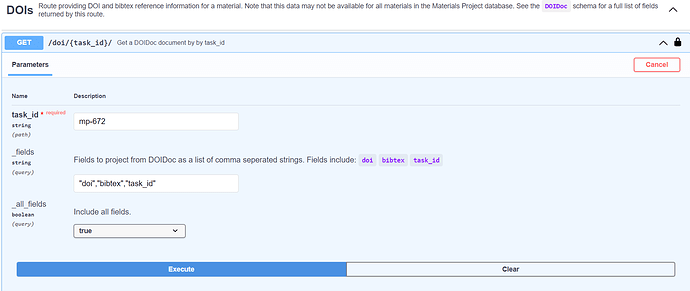```python
with MPRester(api_key) as mpr:
mpr.provenance.search(nsites=(1, …52), elements=["V"])
```
> ```bash
> Traceback (most recent call last):
> File "<string>", line 1, in <module>
> File "C:\Users\sterg\Miniconda3\envs\mp-time-split\lib\site-packages\mp_api\core\client.py", line 786, in search
> return self._get_all_documents(
> File "C:\Users\sterg\Miniconda3\envs\mp-time-split\lib\site-packages\mp_api\core\client.py", line 835, in _get_all_documents
> results = self._query_resource(
> File "C:\Users\sterg\Miniconda3\envs\mp-time-split\lib\site-packages\mp_api\core\client.py", line 288, in _query_resource
> data = self._submit_requests(
> File "C:\Users\sterg\Miniconda3\envs\mp-time-split\lib\site-packages\mp_api\core\client.py", line 387, in _submit_requests
> initial_data_tuples = self._multi_thread(use_document_model, initial_params_list)
> File "C:\Users\sterg\Miniconda3\envs\mp-time-split\lib\site-packages\mp_api\core\client.py", line 587, in _multi_thread
> data, subtotal = future.result()
> File "C:\Users\sterg\Miniconda3\envs\mp-time-split\lib\concurrent\futures\_base.py", line 439, in result
> return self.__get_result()
> File "C:\Users\sterg\Miniconda3\envs\mp-time-split\lib\concurrent\futures\_base.py", line 391, in __get_result
> raise self._exception
> File "C:\Users\sterg\Miniconda3\envs\mp-time-split\lib\concurrent\futures\thread.py", line 58, in run
> result = self.fn(*self.args, **self.kwargs)
> File "C:\Users\sterg\Miniconda3\envs\mp-time-split\lib\site-packages\mp_api\core\client.py", line 652, in _submit_request_and_process
> raise MPRestError(
> mp_api.core.client.MPRestError: REST query returned with error status code 400 on URL https://api.materialsproject.org/provenance/?nsites=1&nsites=52&elements=V&_all_fields=True&_limit=1000 with message:
> Request contains query parameters which cannot be used: nsites, elements
> ```
Note that `nsites` and `elements` are in `available_fields`:
```python
mpr.provenance.available_fields
```
> ```python
> ['builder_meta', 'nsites', 'elements', 'nelements', 'composition', 'composition_reduced', 'formula_pretty', 'formula_anonymous', 'chemsys', 'volume', 'density', 'density_atomic', 'symmetry', 'property_name', ...]
> special variables
> function variables
> 00:'builder_meta'
> 01:'nsites'
> 02:'elements'
> 03:'nelements'
> 04:'composition'
> 05:'composition_reduced'
> 06:'formula_pretty'
> 07:'formula_anonymous'
> 08:'chemsys'
> 09:'volume'
> 10:'density'
> 11:'density_atomic'
> 12:'symmetry'
> 13:'property_name'
> 14:'material_id'
> 15:'deprecated'
> 16:'deprecation_reasons'
> 17:'last_updated'
> 18:'origins'
> 19:'warnings'
> 20:'created_at'
> 21:'references'
> 22:'authors'
> 23:'remarks'
> 24:'tags'
> 25:'theoretical'
> 26:'database_IDs'
> 27:'history'
> len():28
> ```
Similar to #612, `get_data_by_id()` seems to work fine:
```python
mpr.provenance.get_data_by_id('mp-771054')
```
> ```python
> ProvenanceDoc(builder_meta=EmmetMeta(emmet_version='0.18.0', pymatgen_version='2022.0.16', pull_request=644, database_version='2021.11.10', build_date=datetime.datetime(2021, 11, 25, 10, 20, 36, 310000)), nsites=None, elements=None, nelements=None, composition=None, composition_reduced=None, formula_pretty=None, formula_anonymous=None, chemsys=None, volume=None, density=None, density_atomic=None, symmetry=None, property_name='provenance', material_id=MPID(mp-771054), deprecated=False, deprecation_reasons=None, last_updated=datetime.datetime(2021, 11, 25, 10, 20, 36, 310000), origins=[], warnings=[], created_at=datetime.datetime(2021, 11, 25, 10, 20, 36, 310000), references=['@article{Jain2013,\nauthor = {Jain, Anubhav and Ong, Shyue Ping and Hautier, Geoffroy and Chen, Wei and Richards, William Davidson and Dacek, Stephen and Cholia, Shreyas and Gunter, Dan and Skinner, David and Ceder, Gerbrand and Persson, Kristin a.},\ndoi = {10.1063/1.4812323},\nissn = {2166532X},\njournal = {APL Materials},\nnumber = {1},\npages = {011002},\ntitle = {{The Materials Project: A materials genome approach to accelerating materials innovation}},\nurl = {http://link.aip.org/link/AMPADS/v1/i1/p011002/s1\\&Agg=doi},\nvolume = {1},\nyear = {2013}\n}\n\n@misc{MaterialsProject,\ntitle = {{Materials Project}},\nurl = {http://www.materialsproject.org}\n}'], authors=[Author(name='Materials Project', email='[email protected]')], remarks=[], tags=[], theoretical=True, database_IDs={}, history=[History(name='Materials Project Optimized Structure', url='http://www.materialsproject.org', description=None)])
> ```

